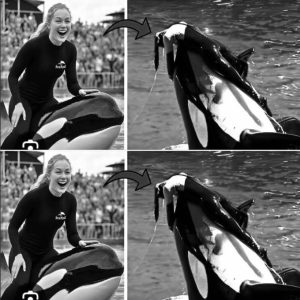Orca trainer is 😱 devoured by this one while perfor…see more

Orca trainer is 😱 devoured by this one while perfor…see more

Left Panel: Joy and Control
Visual Description
- A female trainer in a wetsuit, smiling broadly, is seen riding on top of an orca.
- She appears exuberant and happy, exuding a sense of mastery, comfort, and companionship.
- The orca, sleek and glossy, looks relatively calm and composed.
- In the background, there is a large crowd, likely seated in an amphitheater, suggesting this is part of a marine animal show, possibly at a facility like SeaWorld.
- The branding on her suit further hints at this context.
- The photo conveys a sense of harmony, cooperation, and entertainment.
Implied Themes
- Entertainment vs. Nature: The image projects a polished, crowd-pleasing image of human-animal interaction.
- Control: The human is visibly in a position of dominance, physically riding the orca.
- Public Spectacle: The presence of an audience in the background implies commodification—nature turned into performance.
Right Panel: Brutal Contrast
Visual Description
- A shocking, visceral image: the same orca appears to be holding a human body in its mouth. The figure, dressed similarly to the trainer on the left, hangs limp.
- The water surrounding them is calm, amplifying the violence through contrast.
- The arrow between the two images suggests a cause-and-effect narrative—a “before and after” scenario.
- This is stark, raw, and distressing, especially due to the realism.
Implied Themes
- Nature’s Rebellion: The orca, usually perceived as a majestic and intelligent sea creature, is shown in a primal state—predator rather than performer.
- Captivity Consequences: This may be interpreted as an allegory of nature retaliating against confinement and exploitation.
- Mortal Risk in Animal Performance: Despite years of training, animals remain inherently wild and can become dangerous.
Symbolism and Commentary
This image seems crafted with clear narrative intent, likely as part of activist visual art or social commentary on the ethics of marine parks and animal entertainment. Let’s explore the deeper messages embedded in the visuals.
1. The Duality of Captivity
- The contrast between the cheerful left image and the tragic right image speaks volumes.
- Orcas, although trained and performing, remain apex predators. Their intelligence does not make them docile pets—it makes their captivity more morally complex.
2. Emotional Manipulation and Public Perception
- The left side appeals to public fascination—the awe of watching powerful creatures perform tricks.
- The right side jolts the viewer with emotional whiplash, prompting them to question what happens behind the scenes.
3. Media Narratives
- This layout is similar to those used in awareness campaigns or viral content. The arrow suggests transformation—a moment of change, or the inevitable consequence of unnatural conditions.
- This may be referencing real-life tragedies involving orca attacks, such as the well-known incident with Tilikum, an orca responsible for multiple trainer deaths in captivity, including the tragic death of Dawn Brancheau in 2010 at SeaWorld Orlando.
Psychological and Ethical Reflections
On the Orca
- Orcas are highly intelligent, emotionally sensitive, and social animals.
- In the wild, they travel vast distances and live in tight-knit family pods.
- Captivity, especially in small tanks with enforced isolation or non-family groups, is deeply unnatural and has been shown to cause psychological distress.
- These conditions can lead to aggression, self-harm, or lethargy, all signs of mental deterioration.
On the Trainer
- Trainers often have deep affection for the animals they work with.
- Many consider their role as ambassadors for marine life, believing they help inspire conservation.
- Yet, this job comes with inherent risk—trusting wild predators in a staged setting.
Cultural and Institutional Impact
This image taps into a broader cultural conversation:
- Documentaries like Blackfish (2013) helped shift public perception, exposing the psychological trauma suffered by orcas in captivity and highlighting human fatalities.
- Since then, many marine parks have faced increased scrutiny and some have phased out orca breeding and live performances.
- Society is grappling with the ethics of animal entertainment in a modern context.
Technical Aspects of the Image
- Monochrome Presentation: Black and white filters strip away distractions and focus the viewer on contrast and emotion.
- Juxtaposition Layout: Placing these two moments side by side amplifies their emotional and narrative contrast.
- Arrow Symbol: A simple but powerful visual element indicating progression—perhaps warning or consequence.
Conclusion
This image composition is a powerful storytelling tool—visually simple, emotionally complex, and morally provocative. On the left, it portrays the surface-level joy and spectacle of animal entertainment. On the right, it confronts us with the often-overlooked, tragic potential hidden beneath that surface.
The emotional journey it offers—from delight to horror—mirrors a broader societal awakening. We are urged to question:
- Should wild animals be used for human amusement?
- Can intelligence and emotional depth in animals be ethically reconciled with captivity?
- What is the true cost—both human and animal—of turning nature into a stage?
The photo does not answer these questions outright, but it compels us to look closer—and perhaps, to think deeper.
Would you like me to turn this analysis into a presentation or article layout?
